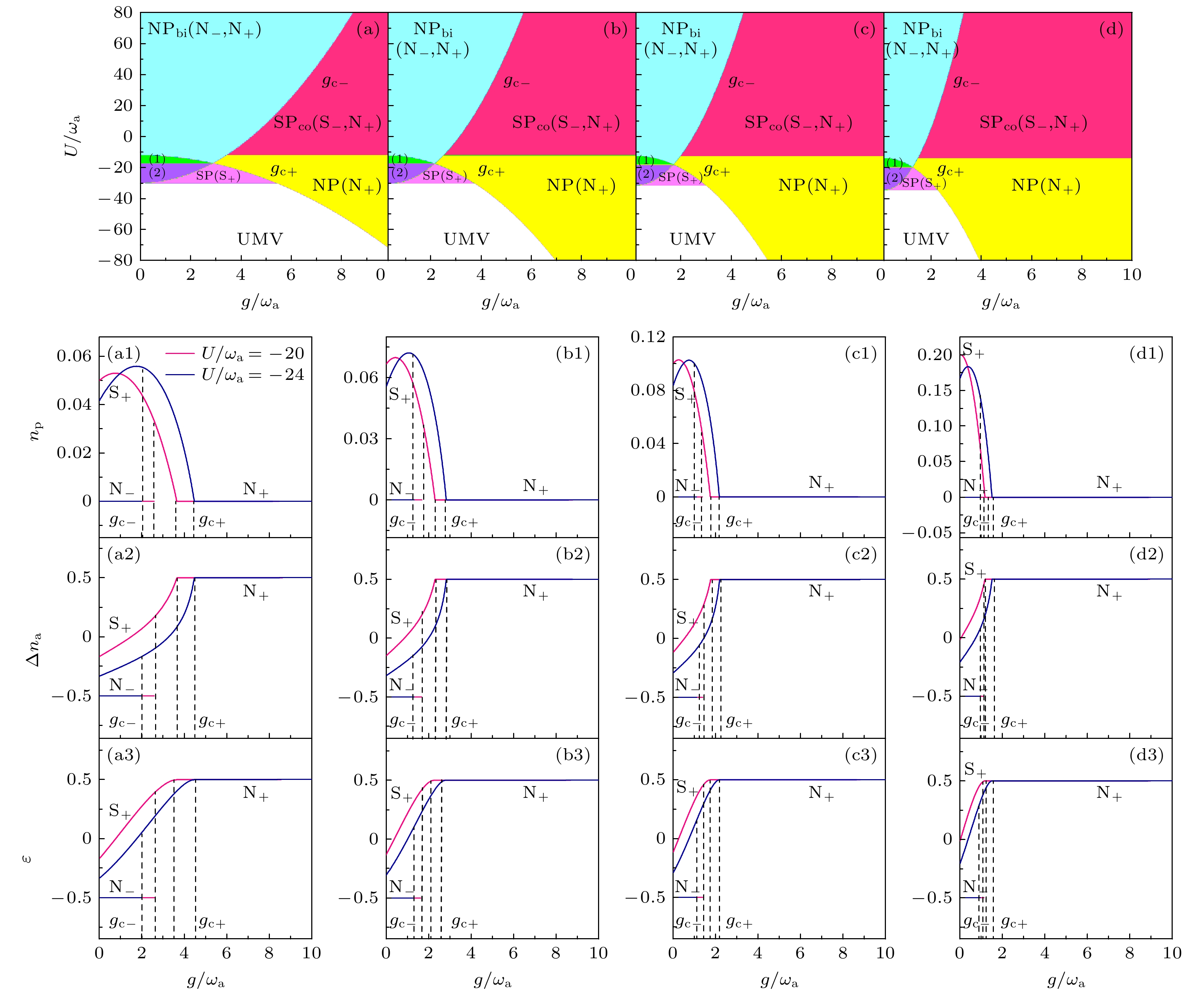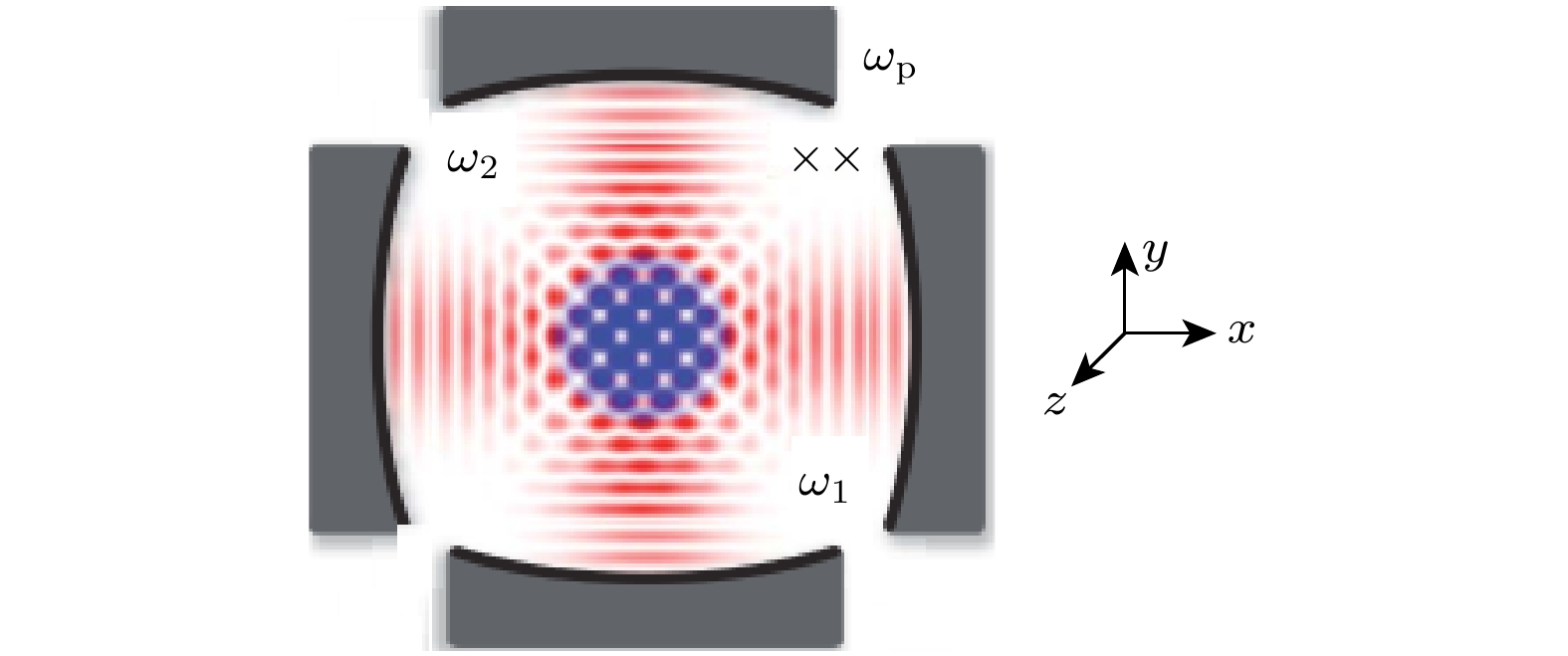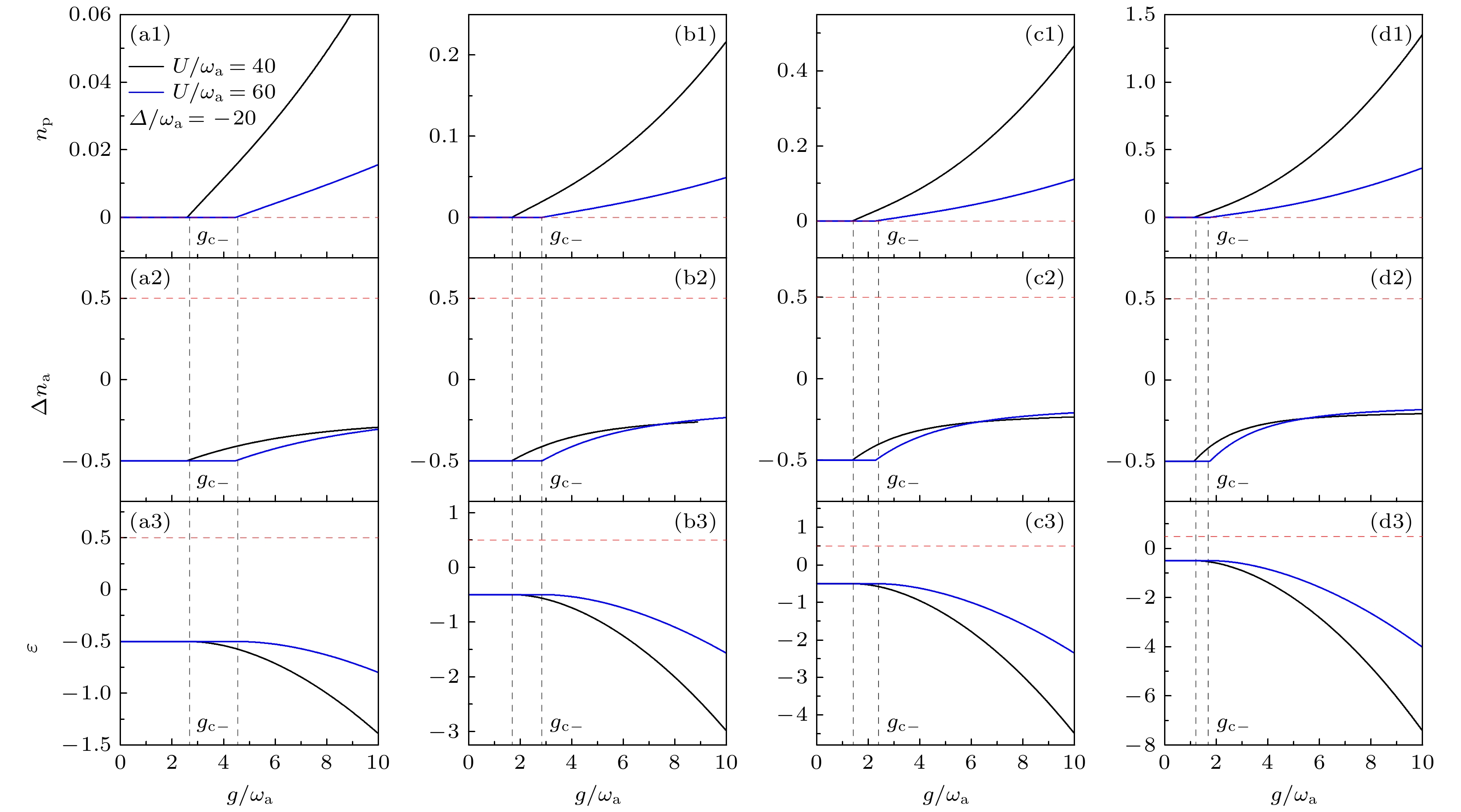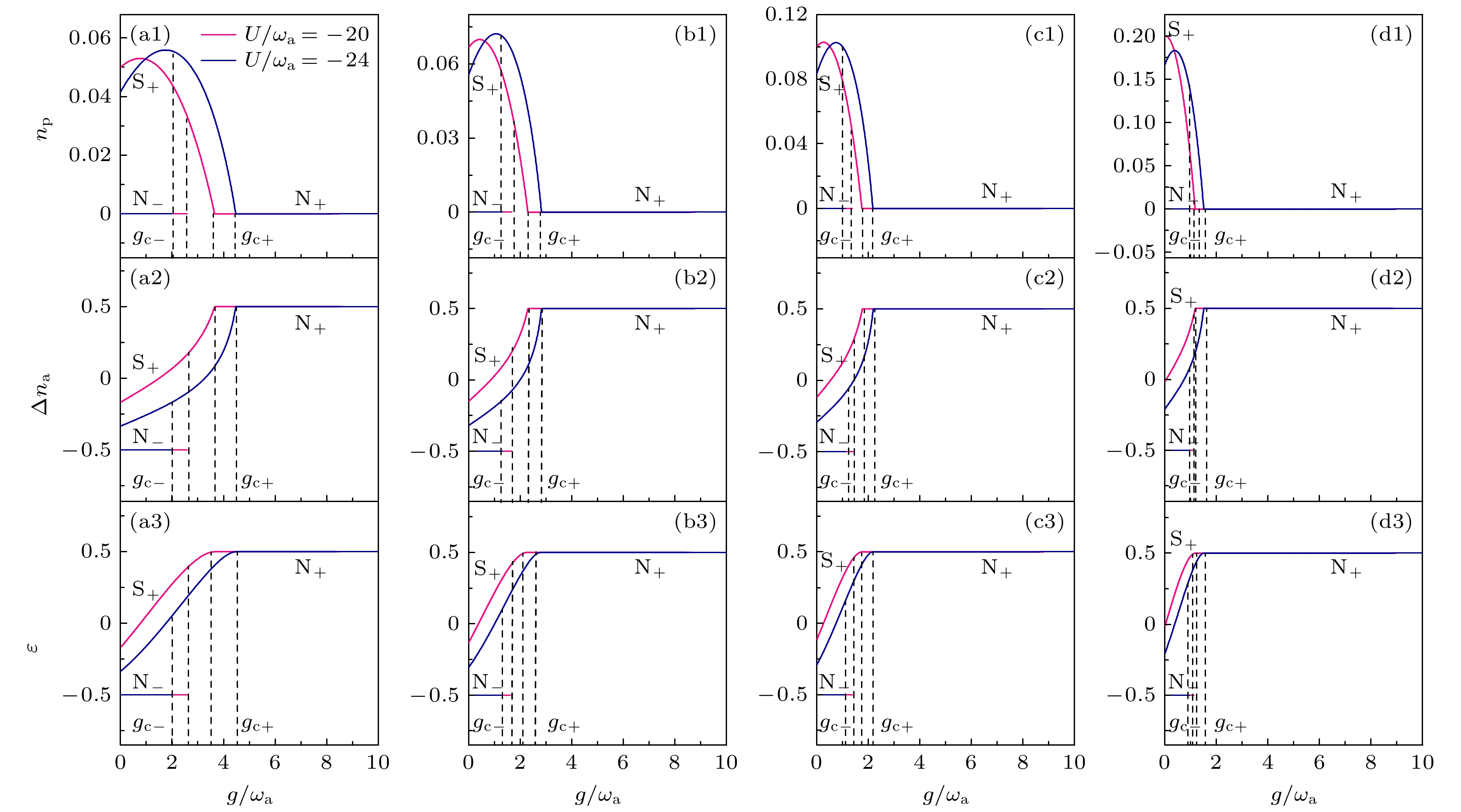-
量子相变是量子光学和凝聚态物理领域的一个重要课题. 本文在标准双模Dicke模型的基础上引入原子-光的非线性相互作用, 研究其所引起的量子相变. 利用自旋相干态变分法从理论上给出有两个参量的基态能量泛函. 两模光场采用四种不同的比例关系进行研究, 并且在实验参数下, 通过可调的原子-光的非线性相互作用参量, 给出了宏观多粒子量子态的丰富结构. 本文主要呈现了在蓝失谐和红失谐下, 双稳的正常相、共存的正常-超辐射相和原子数反转态等丰富的基态特性. 原子-光的非线性相互作用在蓝失谐可以引起标准的双模Dicke模型的正常相到超辐射相的二级量子相变. 在红失谐时引起新奇的基态特性, 新奇的量子相变, 即反转的超辐射相到反转的正常相的二级逆量子相变. 原子-光的非线性相互作用和两模光场比例不同时, 对量子相变的相边界和基态物理量的值有较大影响.
-
关键词:
- 双模Dicke模型 /
- 原子-光的非线性相互作用 /
- 量子相变 /
- 自旋相干态法
Quantum phase transition is an important subject in the field of quantum optics and condensed matter physics. In this work, we study the quantum phase transition of the two-mode Dicke model by using the nonlinear atom-light interaction introduced into the interaction between one mode light field and atom. The spin coherent variational method is used to study macroscopic multi-particle quantum systems. Firstly, the pseudo spin operator is diagonalized to obtain the variational fundamental state energy functional by means of spin coherent state transformation under the condition of coherent state light field. The energy functional is used to find the extreme value of the classical field variable, and the second derivative is determined to find the minimum value, and finally the exact solution of the ground state energy is given. Four different proportional relationships are used to study the two-mode optical field, and the rich structure of macroscopic multi-particle quantum states is given by adjusting atom-optical nonlinear interaction parameters under the experimental parameters. The abundant ground state properties such as bistable normal phase, coexisting normal-superradiation and atomic population inversion under blue and red detuning are presented. The nonlinear atom-light interaction causes blue detuning, and there is also a second-order quantum phase transition from the normal phase to the superradiation phase in the standard two-mode Dicke model. In the case of red detuning, a novel and stable reversed superradiation phase also appears. With the increase of the coupling coefficient, the reversed superradiation phase is transformed into the reversed normal phase. The nonlinear interaction between atoms and light and the different ratio of two modes of light field have great influence on the phase boundary of quantum phase transition, and the region of quantum state, as shown in Fig. (a)–(d). When the nonlinear interaction takes two definite values, the curve of the ground state physical parameters changing with the coupling parameters of atoms and light also reflects the novel second-order inverse quantum phase transition from the reversed superradiation phase to the reversed normal phase in red detuning, as shown in Fig. (a1)–(d3). -
Keywords:
- two-mode Dicke model /
- atomic-optical nonlinear interaction /
- quantum phase transition /
- spin coherent state method
[1] Vojta M 2003 Rep. Prog. Phys. 66 2069
 Google Scholar
Google Scholar
[2] Gu S J 2010 Int. J. Mod. Phys. B 24 4371
 Google Scholar
Google Scholar
[3] 刘妮 2013 物理学报 62 013402
 Google Scholar
Google Scholar
Liu N 2013 Acta Phys. Sin. 62 013402
 Google Scholar
Google Scholar
[4] Dicke R H 1954 Phys. Rev. A 93 99
 Google Scholar
Google Scholar
[5] Clive E, Tobias B 2003 Phys. Rev. E 67 066203
 Google Scholar
Google Scholar
[6] Zanardi P, Paris M G A, Venuti L C 2008 Phys. Rev. A 78 042105
 Google Scholar
Google Scholar
[7] Liu N, Lian J L, Ma J, et al. 2011 Phys. Rev. A 83 033601
 Google Scholar
Google Scholar
[8] Zhao J C, Hwang M J 2022 Phys. Rev. Lett. 128 163601
 Google Scholar
Google Scholar
[9] Zhao X Q, Liu N, Liang J Q 2017 Opt. Express 25 8123
 Google Scholar
Google Scholar
[10] Novokreschenov D, Kudlis A, Iorsh I, Tokatly I V 2023 Phys. Rev. B 108 235424
 Google Scholar
Google Scholar
[11] Wang Q, Robnik M 2020 Phys. Rev. E 102 032212
 Google Scholar
Google Scholar
[12] Tolkunov D, Solenov D 2007 Phys. Rev. B 75 024402
 Google Scholar
Google Scholar
[13] Kirkova A V, Ivanov P A 2023 Phys. Scr. 98 045105
 Google Scholar
Google Scholar
[14] Léonard J, Morales A, Zupancic P, Esslinger T, Donner T 2017 Nature 543 87
 Google Scholar
Google Scholar
[15] Léonard J, Morales A, Zupancic P, Esslinger T 2017 Science 358 1415
 Google Scholar
Google Scholar
[16] Wu Z G, Chen Y, Zhai H 2018 Sci. Bull. 63 542
 Google Scholar
Google Scholar
[17] Qin W, Zheng D C, Wu Z D, Chen Y H, Liao R Y 2024 Phys. Rev. A 109 013310
 Google Scholar
Google Scholar
[18] 俞立先, 梁奇锋, 汪丽蓉, 朱士群 2014 物理学报 63 134204
 Google Scholar
Google Scholar
Yu L X, Liang Q F, Wang L R, Zhu S Q 2014 Acta Phys. Sin. 63 134204
 Google Scholar
Google Scholar
[19] Soldati R R, Mitchison M T, Landi G T 2021 Phys. Rev. A 104 052423
 Google Scholar
Google Scholar
[20] Quezada L F, Nahmad-Achar E 2017 Phys. Rev. A 95 013849
 Google Scholar
Google Scholar
[21] Baumann K, Guerlin C, Brennecke F, Esslinger T 2010 Nature 464 1301
 Google Scholar
Google Scholar
[22] Zhao X Q, Liu N, Liang J Q 2014 Phys. Rev. A 90 023622
 Google Scholar
Google Scholar
[23] Liu N, Zhao X Q, Liang J Q 2019 Int. J. Theor. Phys. 58 558
 Google Scholar
Google Scholar
[24] 杨晓勇, 薛海斌, 梁九卿 2013 物理学报 62 114205
 Google Scholar
Google Scholar
Yang X Y, Xue H B, Liang J Q 2013 Acta Phys. Sin. 62 114205
 Google Scholar
Google Scholar
[25] Larson J, Damski B, Morigi G, Lewenstein M 2008 Phys. Rev. Lett 100 050401
 Google Scholar
Google Scholar
[26] Liu N, Li J D, Liang J Q 2013 Phys. Rev. A 87 053623
 Google Scholar
Google Scholar
[27] Wang Z M, Lian J L, Liang J Q, Yu Y M, Liu W M 2016 Phys. Rev. A 93 033630
 Google Scholar
Google Scholar
-
图 1 双模光腔内捕获超冷原子的实验装置. 等效的N个二能级超冷原子87Rb处于该腔中, x方向有等效的腔频$ {\omega _1} $的光场, y方向上有腔频$ {\omega _2} $的光场, z方向有泵浦激光频率为$ {\omega _{\text{p}}} $, 只调控腔频$ {\omega _1} $
Fig. 1. Experimental setup for a trapped ultra-cold atoms in the dual-mode optical cavity. The equivalent N two-level ultracold atoms are in this cavity, with a equivalent cavity frequency $ {\omega _1} $ light field in the x direction, a cavity frequency $ {\omega _2} $ light field in the y direction, and in the z direction, the pumped laser frequency is $ {\omega _{\text{p}}} $, and only the cavity frequency $ {\omega _1} $ is regulated.
图 3 在蓝失谐下, (a1)—(d1) 总平均光子数$ {n_{\text{p}}} $, (a2)—(d2) 原子布居数差$ \Delta {n_{\text{a}}} $和(a3)—(d3) 平均基态能量$ \varepsilon $随原子-场的耦合强度$ g/{\omega _{\text{a}}} $的变化曲线
Fig. 3. Variations curves of (a1)–(d1) total average photon number $ {n_{\text{p}}} $, (a2)–(d2) atomic population imbalance $ \Delta {n_a} $ and (a3)–(d3) average ground state energy $ \varepsilon $ with the atom-field coupling intensity $ g/{\omega _{\text{a}}} $ under the blue detuning.
图 4 在蓝失谐下, (a)基态能量对g 的一阶偏导$ \partial {\varepsilon _ - }/\partial g $和(b)二阶偏导$ {\partial ^2}{\varepsilon _ - }/\partial {g^2} $随g的变化曲线
Fig. 4. Under blue detuning, the first-order deflection $ \partial {\varepsilon _ - }/\partial g $ (a) ground state energy with respect to g and the second-order deflection $ {\partial ^2}{\varepsilon _ - }/\partial {g^2} $ (b) change curve with respect to g.
图 6 红失谐下(a1)—(d1)总平均光子数分布$ {n_{\text{p}}} $, (a2)—(d2)原子布居数差分布$ \Delta {n_{\text{a}}} $和(a3)—(d3)平均基态能量$ \varepsilon $随原子-场耦合强度$ g/{\omega _{\text{a}}} $的变化曲线
Fig. 6. Variations curves of (a1)–(d1) total average photon number $ {n_{\text{p}}} $, (a2)–(d2) atomic population imbalance $ \Delta {n_{\text{a}}} $, and (a3)–(d3) average ground state energy with the atom-field coupling coefficient $ g/{\omega _{\text{a}}} $under the red detuning.
图 7 在红失谐下, (a)基态能量对g 的一阶偏导$ \partial {\varepsilon _ + }/\partial g $和(b)二阶偏导$ {\partial ^2}{\varepsilon _ + }/\partial {g^2} $随$ g/{\omega _{\text{a}}} $的变化曲线
Fig. 7. Under red detuning, the first-order deflection $ \partial {\varepsilon _ + }/\partial g $ (a) ground state energy with respect to g and the second-order deflection $ {\partial ^2}{\varepsilon _ + }/\partial {g^2} $ (b) change curve with respect to $ g/{\omega _{\text{a}}} $.
表 1 蓝失谐时相应相图的参数($ U $作变量)
Table 1. Parameters of the corresponding phase diagram when blue detuning ($ U $ as variable).
$ \varphi $ $ {\tan ^2}\varphi $ $ 1 + \tan \varphi $ $ {{{g_{{\text{c}} - }}}}/{{{\omega _{\text{a}}}}} $ $ {{{g_{{\text{c}} + }}}}/{{{\omega _{\text{a}}}}} $ a 0 0 1 $ \dfrac{1}{{\sqrt 3 }}\sqrt {\dfrac{{2 U}}{{{\omega _{\text{a}}}}} - 60} , \quad \dfrac{U}{{{\omega _{\text{a}}}}} \gt 30 $ $ \dfrac{1}{{\sqrt 3 }}\sqrt {60 - \dfrac{{5 U}}{{{\omega _{\text{a}}}}}} , \quad \dfrac{U}{{{\omega _{\text{a}}}}} \lt 12 $ b $ \dfrac{\pi }{6} $ $ \dfrac{1}{3} $ $ 1 + \dfrac{{\sqrt 3 }}{3} $ $ \dfrac{1}{{1 + \sqrt 3 }}\sqrt {\dfrac{{2 U}}{{{\omega _{\text{a}}}}} - 59} , \quad \dfrac{U}{{{\omega _{\text{a}}}}} \gt 29.5 $ $ \dfrac{1}{{1 + \sqrt 3 }}\sqrt {59 - \dfrac{{5 U}}{{{\omega _{\text{a}}}}}} , \quad \dfrac{U}{{{\omega _{\text{a}}}}} \lt 11.8 $ c $ \dfrac{\pi }{4} $ $ 1 $ 2 $ \dfrac{1}{{2\sqrt 3 }}\sqrt {\dfrac{{2 U}}{{{\omega _{\text{a}}}}} - 57} , \quad \dfrac{U}{{{\omega _{\text{a}}}}} \gt 28.5 $ $ \dfrac{1}{{2\sqrt 3 }}\sqrt {57 - \dfrac{{5 U}}{{{\omega _{\text{a}}}}}} , \quad \dfrac{U}{{{\omega _{\text{a}}}}} \lt 11.4 $ d $ \dfrac{{\text{π}}}{3} $ $ 3 $ $ 1 + \sqrt 3 $ $ \dfrac{1}{{3 + \sqrt 3 }}\sqrt {\dfrac{{2 U}}{{{\omega _{\text{a}}}}} - 51} , \quad \dfrac{U}{{{\omega _{\text{a}}}}} \gt 25.5 $ $ \dfrac{1}{{3 + \sqrt 3 }}\sqrt {51 - \dfrac{{5 U}}{{{\omega _{\text{a}}}}}} , \quad \dfrac{U}{{{\omega _{\text{a}}}}} \lt 10.2 $ 表 2 相变点$ {g_{{\text{c}} - }} $的精确值
Table 2. Exact value of the phase transition point $ {g_{{\text{c}} - }} $.
$ \varphi $ $ \omega ' $ $ g' $ $ {g_{{\text{c}} - }}/{\omega _{\text{a}}} $ $ {\text{ }}U/{\omega _{\text{a}}} = 40 $ $ {\text{ }}U/{\omega _{\text{a}}} = 60 $ a 0 $ {\omega _1} $ $ g $ 2.59 4.48 b $ {{\text{π}}}/{6} $ $ {\omega _1} + \dfrac{{{\omega _2}}}{3} $ $ g \Big(1 + \dfrac{{\sqrt 3 }}{3}\Big) $ 1.68 2.87 c $ {{\text{π}}}/{4} $ $ {\omega _1} + {\omega _2} $ $ 2 g $ 1.38 2.30 d $ {{\text{π}}}/{3} $ $ {\omega _1} + 3{\omega _2} $ $ g(1 + \sqrt 3 ) $ 1.14 1.76 表 3 红失谐相应图形的参数($ U $作变量)
Table 3. Parameters of the corresponding phase diagram when red detuning ($ U $ as variable).
$ \varphi $ $ {g_{{\text{c}} - }}/{\omega _{\text{a}}} $ $ {g_{{\text{c}} + }}/{\omega _{\text{a}}} $ $ {U}/{{{\omega _{\text{a}}}}} ~\left( {\omega ' \lt 0} \right) $ a 0 $ \dfrac{1}{{\sqrt 3 }}\sqrt {60 + \dfrac{{2 U}}{{{\omega _{\text{a}}}}}} , {\text{ }}\dfrac{U}{{{\omega _{\text{a}}}}} \gt - 30 $ $ \dfrac{1}{{\sqrt 3 }}\sqrt { - 60 - \dfrac{{5 U}}{{{\omega _{\text{a}}}}}} , {\text{ }}\dfrac{U}{{{\omega _{\text{a}}}}} \lt - 12 $ $ 20 + \dfrac{{7 U}}{{6{\omega _{\text{a}}}}} \lt 0, {\text{ }}\dfrac{U}{{{\omega _{\text{a}}}}} \lt - 17.14 $ b $ \dfrac{{\text{π}}}{6} $ $ \dfrac{1}{{1 + \sqrt 3 }}\sqrt {61 + \dfrac{{2 U}}{{{\omega _{\text{a}}}}}} , {\text{ }}\dfrac{U}{{{\omega _{\text{a}}}}} \gt - 30.5 $ $ \dfrac{1}{{1 + \sqrt 3 }}\sqrt { - 61 - \dfrac{{5 U}}{{{\omega _{\text{a}}}}}} , {\text{ }}\dfrac{U}{{{\omega _{\text{a}}}}} \lt - 12.2 $ $ 20 + \dfrac{{7 U}}{{6{\omega _{\text{a}}}}} + \dfrac{1}{3} \lt 0, {\text{ }}\dfrac{U}{{{\omega _{\text{a}}}}} \lt - 17.43 $ c $ \dfrac{{\text{π}}}{4} $ $ \dfrac{1}{{2\sqrt 3 }}\sqrt {63 + \dfrac{{2 U}}{{{\omega _{\text{a}}}}}} , {\text{ }}\dfrac{U}{{{\omega _{\text{a}}}}} \gt - 31.5 $ $ \dfrac{1}{{2\sqrt 3 }}\sqrt { - 63 - \dfrac{{5 U}}{{{\omega _{\text{a}}}}}} , {\text{ }}\dfrac{U}{{{\omega _{\text{a}}}}} \lt - 12.6 $ $ 20 + \dfrac{{7 U}}{{6{\omega _{\text{a}}}}} + 1 \lt 0, {\text{ }}\dfrac{U}{{{\omega _{\text{a}}}}} \lt - 18 $ d $ \dfrac{{\text{π}}}{3} $ $ \dfrac{1}{{3 + \sqrt 3 }}\sqrt {69 + \dfrac{{2 U}}{{{\omega _{\text{a}}}}}} , {\text{ }}\dfrac{U}{{{\omega _{\text{a}}}}} \gt - 34.5 $ $ \dfrac{1}{{3 + \sqrt 3 }}\sqrt { - 69 - \dfrac{{5 U}}{{{\omega _{\text{a}}}}}} , {\text{ }}\dfrac{U}{{{\omega _{\text{a}}}}} \lt - 13.8 $ $ 20 + \dfrac{{7 U}}{{6{\omega _{\text{a}}}}} + 3 \lt 0, {\text{ }}\dfrac{U}{{{\omega _{\text{a}}}}} \lt - 19.71 $ 表 4 $ \text{ }U/{\omega }_{a}=-20, \text{ }-24 $时, $ {g_{{\text{c}} - }} $和$ {g_{{\text{c}} + }} $的值
Table 4. Values of $ {g_{{\text{c}} - }} $ and $ {g_{{\text{c}} + }} $ at $ U/{\omega _{\text{a}}} = - 20, {\text{ }} - 24 $.
$ \varphi $ $ {g_{{\text{c}} - }}/{\omega _{\text{a}}} $ $ {g_{{\text{c}} + }}/{\omega _{\text{a}}} $ $ {g_{{\text{c}} - }}/{\omega _{\text{a}}} = - 20 $ $ {g_{{\text{c}} - }}/{\omega _{\text{a}}} = - 24 $ $ \text{ }U/{\omega }_{\text{a}}=-20 $ $ \text{ }U/{\omega }_{\text{a}}=-24 $ a $ 0 $ 2.58 2.00 3.65 4.47 b $ {{\text{π}}}/{6} $ 1.68 1.32 2.29 2.81 c $ {{\text{π}}}/{4} $ 1.38 1.12 1.76 2.18 d $ {{\text{π}}}/{3} $ 1.14 0.97 1.18 1.51 表 5 $ \text{ }U/{\omega }_{\text{a}}=-14, \text{ }-16 $, $ {g_{{\text{c}} - }} $和$ {g_{{\text{c}} + }} $值
Table 5. Values of $ {g_{{\text{c}} - }} $ and $ {g_{{\text{c}} + }} $ at $ \text{ }U/{\omega }_{\text{a}}=-14\text{, }-16 $.
$ \varphi $ $ {g_{{\text{c}} - }}/{\omega _{\text{a}}} $ $ {g_{{\text{c}} + }}/{\omega _{\text{a}}} $ $ \text{ }U/{\omega }_{\text{a}}=-14 $ $ \text{ }U/{\omega }_{\text{a}}=-16 $ $ \text{ }U/{\omega }_{\text{a}}=-14 $ $ \text{ }U/{\omega }_{\text{a}}=-16 $ a $ 0 $ 3.27 3.06 1.83 2.58 b $ {{\text{π}}}/{6} $ 2.10 1.97 1.10 1.60 c $ {{\text{π}}}/{4} $ 1.71 1.61 0.76 1.19 d $ {{\text{π}}}/{3} $ 1.35 1.29 0.21 0.70 -
[1] Vojta M 2003 Rep. Prog. Phys. 66 2069
 Google Scholar
Google Scholar
[2] Gu S J 2010 Int. J. Mod. Phys. B 24 4371
 Google Scholar
Google Scholar
[3] 刘妮 2013 物理学报 62 013402
 Google Scholar
Google Scholar
Liu N 2013 Acta Phys. Sin. 62 013402
 Google Scholar
Google Scholar
[4] Dicke R H 1954 Phys. Rev. A 93 99
 Google Scholar
Google Scholar
[5] Clive E, Tobias B 2003 Phys. Rev. E 67 066203
 Google Scholar
Google Scholar
[6] Zanardi P, Paris M G A, Venuti L C 2008 Phys. Rev. A 78 042105
 Google Scholar
Google Scholar
[7] Liu N, Lian J L, Ma J, et al. 2011 Phys. Rev. A 83 033601
 Google Scholar
Google Scholar
[8] Zhao J C, Hwang M J 2022 Phys. Rev. Lett. 128 163601
 Google Scholar
Google Scholar
[9] Zhao X Q, Liu N, Liang J Q 2017 Opt. Express 25 8123
 Google Scholar
Google Scholar
[10] Novokreschenov D, Kudlis A, Iorsh I, Tokatly I V 2023 Phys. Rev. B 108 235424
 Google Scholar
Google Scholar
[11] Wang Q, Robnik M 2020 Phys. Rev. E 102 032212
 Google Scholar
Google Scholar
[12] Tolkunov D, Solenov D 2007 Phys. Rev. B 75 024402
 Google Scholar
Google Scholar
[13] Kirkova A V, Ivanov P A 2023 Phys. Scr. 98 045105
 Google Scholar
Google Scholar
[14] Léonard J, Morales A, Zupancic P, Esslinger T, Donner T 2017 Nature 543 87
 Google Scholar
Google Scholar
[15] Léonard J, Morales A, Zupancic P, Esslinger T 2017 Science 358 1415
 Google Scholar
Google Scholar
[16] Wu Z G, Chen Y, Zhai H 2018 Sci. Bull. 63 542
 Google Scholar
Google Scholar
[17] Qin W, Zheng D C, Wu Z D, Chen Y H, Liao R Y 2024 Phys. Rev. A 109 013310
 Google Scholar
Google Scholar
[18] 俞立先, 梁奇锋, 汪丽蓉, 朱士群 2014 物理学报 63 134204
 Google Scholar
Google Scholar
Yu L X, Liang Q F, Wang L R, Zhu S Q 2014 Acta Phys. Sin. 63 134204
 Google Scholar
Google Scholar
[19] Soldati R R, Mitchison M T, Landi G T 2021 Phys. Rev. A 104 052423
 Google Scholar
Google Scholar
[20] Quezada L F, Nahmad-Achar E 2017 Phys. Rev. A 95 013849
 Google Scholar
Google Scholar
[21] Baumann K, Guerlin C, Brennecke F, Esslinger T 2010 Nature 464 1301
 Google Scholar
Google Scholar
[22] Zhao X Q, Liu N, Liang J Q 2014 Phys. Rev. A 90 023622
 Google Scholar
Google Scholar
[23] Liu N, Zhao X Q, Liang J Q 2019 Int. J. Theor. Phys. 58 558
 Google Scholar
Google Scholar
[24] 杨晓勇, 薛海斌, 梁九卿 2013 物理学报 62 114205
 Google Scholar
Google Scholar
Yang X Y, Xue H B, Liang J Q 2013 Acta Phys. Sin. 62 114205
 Google Scholar
Google Scholar
[25] Larson J, Damski B, Morigi G, Lewenstein M 2008 Phys. Rev. Lett 100 050401
 Google Scholar
Google Scholar
[26] Liu N, Li J D, Liang J Q 2013 Phys. Rev. A 87 053623
 Google Scholar
Google Scholar
[27] Wang Z M, Lian J L, Liang J Q, Yu Y M, Liu W M 2016 Phys. Rev. A 93 033630
 Google Scholar
Google Scholar
计量
- 文章访问数: 3959
- PDF下载量: 115
- 被引次数: 0















 下载:
下载:







